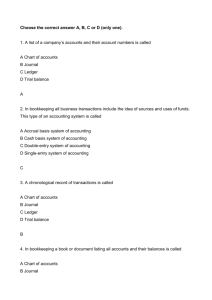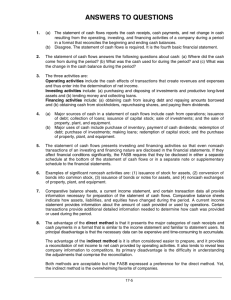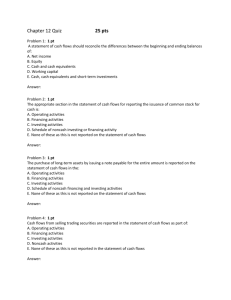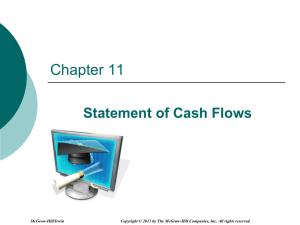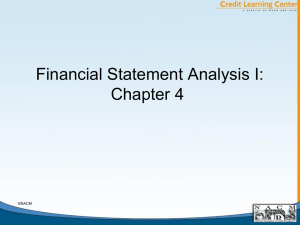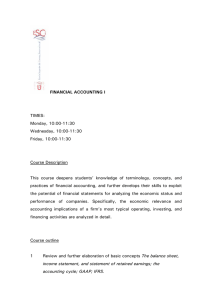The Statement of Cash Flows
advertisement
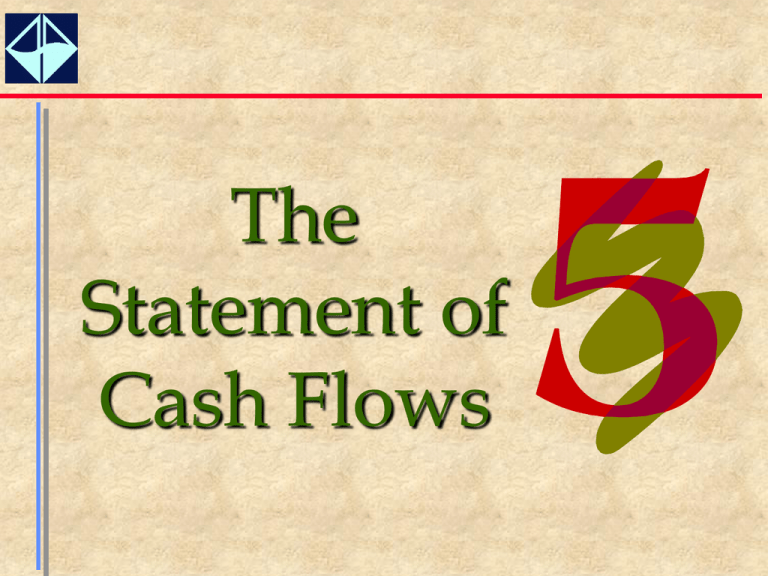
The Statement of Cash Flows 2 Learning Objectives Describe the circumstances in which the cash flow statement is a particularly important companion of the income statement. Outline the structure of and information reported in the three main categories of the cash flow statement: operating, investing, and financing. 3 Learning Objectives Appreciate the historical process involved in the development of the modern statement of cash flows. Compute cash flow from operations using either the direct or the indirect method. Prepare a complete statement of cash flows and provide the required supplemental disclosures. 4 Learning Objectives Understand the differences among cash flow statements prepared according to U.S. GAAP, U.K. GAAP, and International Accounting Standards. Assess a firm’s financial strength by analyzing the relationships among cash flows from operating, investing, and financing activities and by computing financial ratios based on cash flow data. 5 Learning Objectives Use knowledge of how the three primary financial statements tie together in order to prepare a forecasted statement of cash flows. EXPANDED MATERIAL Use a T-account or work sheet approach to prepare a statement of cash flows. What Good Is a Cash Flow Statement? Does a statement of cash flows tell us anything we don’t already know from other statements? 6 What Good Is a Cash Flow Statement? Yes, Also,because everything thereyou are Finally, a statement of cash want situations to know where about neta flows is an excellent company income does is summarized not give us forecasting tool. inanthis accurate one statement. picture. 7 8 Purposes of Cash Flow Statement • Statement of Cash Flows--The primary financial statement that summarizes an entity’s cash receipts and payments during a period. • Predicts an entity’s ability to: – generate positive future cash flows. – meet current and long-term obligations. – pay future dividends. 9 Cash Equivalent It must be readily convertible to cash and it must be so near to maturity It is a short-term, that there is insignificant risks of What is changes a cash in value due to highly liquid changes in equivalent? interest rate.investment. 10 Three Categories of Cash Flows Cash Inflows Operating Activities Investing Activities Financing Activities 11 Cash Flow Categories Operating Activities--Transactions and events that enter into the determination of net income. Investing Activities--Transactions and events that involve the purchase and sale of securities, property, plant, equipment, and other assets not generally held for resale, and the making and collecting of loans. Financing Activities--Transactions and events whereby cash is obtained from or repaid to owners and creditors. General Format of a Statement of Cash Flows Cash Provided by or Used in: Operating Activities $XXX Investing Activities XXX Financing Activities XXX Net Increase (Decrease) in Cash $XXX Cash--Beginning of Year XXX Cash--End of Year $XXX 12 13 Operating Activities Cash Inflow Cash Outflow • Cash Receipt of Sales •Inventory Payments • Collection of •Interest Payments Receivables •Wages • Interest Revenue •Utilities • Dividend Revenue •Rent 14 Investing Activities Cash Inflow Cash Outflow • Sale of plant assets • Purchase of plant assets • Sale of securities, • Purchase of securities, other than trading other than trading securities securities • Collection of • Making of loans with principal on loans other entities 15 Financing Activities Cash Inflow Cash Outflow • Issuance of own • Dividend payments stock • Repayment of • Borrowings loans • Treasury stock purchase 16 Noncash Transactions Noncash Transactions--Investing and financing activities that do not affect an entity’s cash flow. Significant transactions should be disclosed separately. These transactions do not affect the statement of cash flows. 17 Reporting Operating Cash Flows • Direct Method--A method of reporting net cash flows from operations that shows cash receipts and payments for a period of time. This method is more straight forward. • Indirect Method--A method of reporting net cash flow from operations that involves reconciling net income to a cash basis. It shows how noncash flows affect net income. 18 The Direct Method • This method reports directly the major classes of operating cash receipts and payments of an entity during a period. • Accrual-basis revenues and expenses must be converted to equivalent cash receipts and payments. • The amount of cash actually collected or paid is determined. 19 Example: Cash Receipts Sales and Cash Collected from Customers: Beginning accounts receivable $140 + Sales 150 = Cash available for collection $190 - Ending accounts receivable 60 = Cash collected from customers $130 20 Example: Inventory Cost of Goods Sold and Cash Paid for Inventory: Ending inventory $ 75 + Cost of goods sold 80 = Required inventory $155 - Beginning inventory 100 = Cash paid for inventory this year $ 55 21 Example: Wages Wages Expense and Cash Paid for Wages: Beginning wages payable $ 7 + Wages expense 25 = Total obligation to employee $32 - Ending wages payable 10 = Cash paid for wages $22 22 Indirect Method The indirect method makes the following adjustments: • Adjustments for receivables and other current operating assets. • Adjustments for payables and other current liabilities. • Adjustments for depreciation and other noncash items. • Adjustments for gains and losses. Adjustments for Gains and Losses Gains or losses do not represent the cash effect of the transaction. Account Adjustment to Net Income Losses Gains These adjustments are made to net income since the sale of an investment is an investing activity, not an operating activity. 23 24 Adjustments for Receivables Changes in accounts directly affect revenues recorded on an accrual basis. Account Accounts Receivable Accounts Receivable Account Change Adjustment to Net Income 25 Adjustments for Payables Changes in liabilities mean the reverse of changes in current operating asset accounts. Account Accounts Payable Accounts Payable Account Change Adjustment to Net Income 26 Noncash Adjustments • Depreciation and similar noncash items do not affect cash and are not reported on the statement of cash flows. • Any noncash item that reduces net income should be added back to net income in the indirect method. • Any noncash item that increases net income should be subtracted from net income in the indirect method. 27 Relationship Between Net Income and Operating Cash Flow Business engages in operating activities Cash is received and disbursed Operating cash flow “Undo” accrual accounting to get back to cash flow Apply accrual accounting rules Net income Steps for Preparing a Cash Flow Statement Compute how much the cash balance changed during the year. Convert the income statement from an accrual-basis to a cash-basis summary of operations. a. Eliminate expenses that do not involve the outflow of cash, such as depreciation. b. Eliminate gains and losses associated with investing or financing activities. c. Adjust for changes in the balances of current assets and current liabilities. 28 Steps for Preparing a Cash Flow Statement Analyze the long-term assets to identify the cash flow effects of investing activities. Analyze the long-term debt and stockholders’ equity accounts to determine the cash flow effects of any financing transactions. Make sure that the total net cash flow from operating, investing, and financing activities is equal to the net increase or decrease in cash as computed in Step 1. Then, prepare a formal statement of cash flows. Prepare supplement disclosure of significant noncash transactions. 29 Example: Comparative Balance Sheet Assets Cash and Cash Equivalents Accounts Receivable Inventory Equipment Accumulated Depreciation Total Assets Liabilities and Equity Accounts Payable Long-Term Notes Payable Common Stock Retained Earnings Total Liabilities and Equity 30 20X2 $ 82 180 170 200 (72) $560 20X1 $ 40 150 200 140 (60) $470 $100 100 250 110 $560 $ 80 50 250 90 $470 31 Income Statement, 20X1 Sales Expenses: Cost of Goods Sold Selling and General Expense Depreciation Interest Expense Operating Income Gain from Sale of Equipment Income before Income Taxes Income Tax Expense Net Income $345 $120 58 20 2 200 $145 5 $140 30 $110 32 Step 1 Determine change in cash and cash equivalents: Cash 20X1........................... $ 40 Cash 20X2........................... 82 Change in Cash................... $ 42 33 Step 2 Convert from an accrual-basis to a cashbasis summary of operations: EXAMPLE: Eliminate depreciation expense, $44, because it does not require the use of cash. Cash Provided by Operations Accumulated Depreciation 44 (T-account or work sheet entry) 44 34 Step 2 Convert from an accrual-basis to a cashbasis summary of operations: EXAMPLE: Eliminate the $5 gain from selling equipment. Cash 33 Add back $5 to cash provided by operations. Accumulated Depreciation 32 Equipment Gain on Sale of Equipment 60 5 35 Step 3 Analyze the long-term assets to identify the cash flow effects of investing activities. Expenditures for Property, Plant, and Equipment: Beginning equipment $140 - Equipment sold during the year 60 = $ 80 - Ending equipment 200 = Expenditures for equipment during year $120 36 Step 4 Analyze the long-term debt and stockholders’ equity accounts to determine the cash flow effects of any financing transactions: Expenditures for Long-Term Debt: Beginning L-T notes payable balance - Notes reacquired during the year = - Ending L-T notes payable balance = L-T notes payable issued during year $ 50 0 $ 50 100 $ 50 37 Step 4 Analyze the long-term debt and stockholders’ equity accounts to determine the cash flow effects of any financing transactions: Payment of Dividends: Beginning retained earnings balance + Net income = - Ending retained earnings balance = Dividends paid $ 90 110 $200 110 $ 90 38 Steps 5 and 6 Steps 5 and 6 relate to actually preparing the formal and supplementary statements. Operating Activities Section: Indirect Method Cash Flows from Operating Activities: Net Income Adjustments: Depreciation Expense Gain on Sale of Equipment Increase in Accounts Receivable Decrease in Inventory Increase in Accounts Payable Net Cash Provided by Operating Activities $110 44 (5) (30) 30 20 $169 Continued on slide 42 39 Operating Activities Section: Direct Method Cash Flows from Operating Activities: Cash Collected from Customers $ 414 Cash Payments for: Inventory (155) Selling & General Expenses (58) Interest (2) Income Taxes (30) $(245) Net Cash Provided by Operating Activities $169 Continued on slide 42 4 0 Investing and Financing Activities Sections The investing and financing sections are the same whether the direct or indirect approach is used. 41 Investing and Financing Activities Sections Cash Flows from Investing Activities: Continued from either Proceeds from Sale of Equipment slide 39 or 40 Purchase of equipment Net Cash Provided by Investing Activities Cash Flows from Financing Activities: Issuance of Long-Term Notes Payable Payment of Cash Dividends Net Cash Used for Financing Activities Net Increase in Cash Cash, January 1, 2001 Cash, December 31, 2001 $ 33 (120) $(87) 50 (90) $(40) $ 42 40 $ 82 42 43 The End

